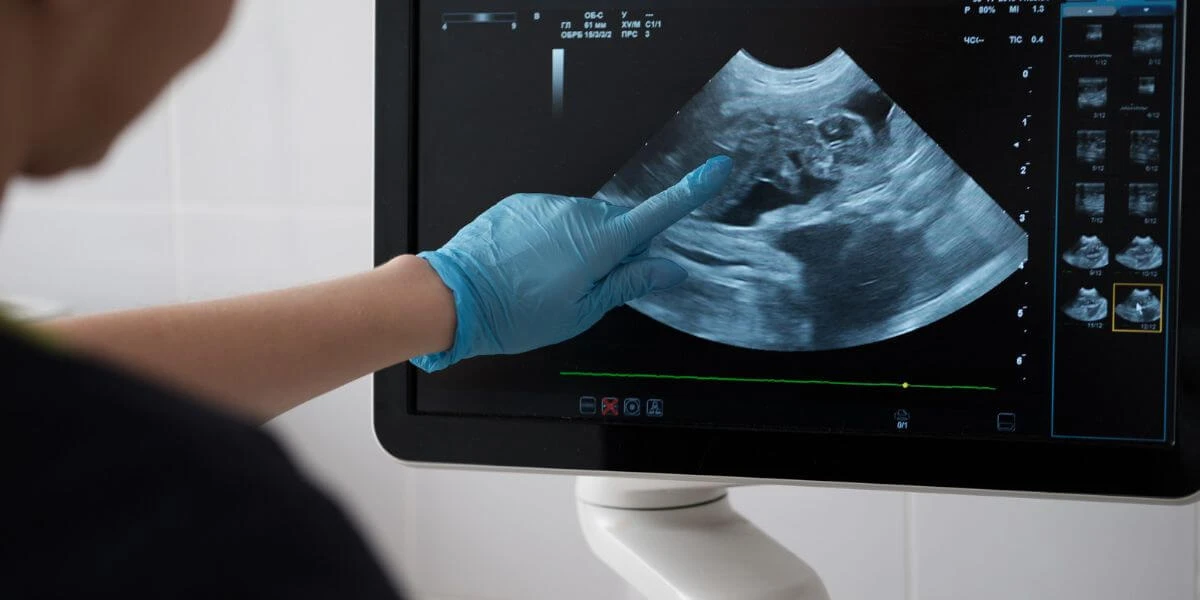Pregnancy scans use ultrasound technology to give you a sneak peek of life on the inside. Hello, peanut!
Ultrasound scans are a valuable tool for checking fetal growth, health, and development during pregnancy.
They can also give you inside info on what your baby’s sex might be at birth (if you want to know, of course) — and the first glimpse of the little being growing inside you.
So what is this wizardry?
And what scans can you expect to have during your pregnancy?
We’ll take you through everything you need to know.
In this article: 📝
- What is an ultrasound scan?
- What are the different types of ultrasounds during pregnancy?
- How many ultrasounds do you get during pregnancy?
- How many ultrasounds in the first trimester?
- What is a dating scan?
- What is nuchal translucency screening?
- When is the second trimester ultrasound done?
- What is an anatomy scan?
- When is the third trimester ultrasound done
- Are ultrasounds safe during pregnancy?
- How many ultrasounds are safe during pregnancy?
- What should I do before a pregnancy scan?

What is an ultrasound scan?
An ultrasound scan is a non-invasive medical test that gives healthcare professionals the opportunity to safely view the inside of the body.
Ultrasound technology is used for various purposes, including diagnosing certain medical conditions (such as thyroid conditions) and guiding some surgical procedures, like breast biopsies.
It’s also incredibly valuable during pregnancy because it can help your medical team safely monitor your baby’s health, growth, and development.
With the help of a special instrument called a transducer, ultrasound scans work by sending high-frequency sound waves through your body.
These waves head into your body’s interior, bouncing off the solid structures they come in contact with, like organs, bones, and the little creature growing inside you.
The information these “echoes” provide is then sent back through the transducer to create images that can be seen on a computer screen while the scan is happening.
Pretty amazing. 🪄
How is an ultrasound scan done?
The medical professional trained to perform this kind of test is called a sonographer.
Most ultrasounds are done in 2D, meaning they produce a flat image like a photograph.
In some cases, your doctor may ask for a 3D ultrasound if they need to see anything in more detail.
Here, multiple 2D images are taken from various angles to create a 3D visual.
Very rarely, you may be offered a 4D or a 5D scan.
This goes one step further and is able to show movement. 🤸♀️

What are the different types of ultrasounds during pregnancy?
Depending on when and why you have your pregnancy scan, you may either have a transabdominal or transvaginal scan.
We’ll take you through the details of each.
1. Transabdominal ultrasound scan
For a transabdominal scan, the transducer is moved along your belly to create an image on the computer screen.
First, a gel will be applied to your bump.
(It’s usually aloe vera, as this tends not to irritate the skin.)
The gel allows the transducer to move smoothly over your belly so that it can get to work making images.
Transabdominal ultrasounds are usually used from about 12 weeks on for routine ultrasounds.
It’s a good idea to arrive at your appointment with a full bladder. (We’ll give you the full scoop on why below.)
2. Transvaginal ultrasound scan
You may also hear this type of scan called an “internal ultrasound,” an “endovaginal ultrasound,” or a “pelvic ultrasound.”
During a transvaginal ultrasound scan, a wand-shaped transducer is covered with a latex sheath, lubricated, and then inserted into your vagina.
(While this can be a little uncomfortable, the good news is that it’s not painful.)
A transvaginal ultrasound is usually done early on in pregnancy.
Because the transducer is placed inside your body, it’s usually able to give a very clear view of the uterus and the growing fetus.
This type of scan can help your medical team see how long you’ve been pregnant (i.e., calculate gestational age) and even detect a fetal heartbeat.
(Don’t worry if you can’t hear a heartbeat at an early ultrasound, though. Sometimes, those flutters take a bit more time to make themselves known.)
While it’s safe to have a transvaginal ultrasound right up until your third trimester, it’s more likely that your healthcare team will opt for the transabdominal approach as your due date approaches.
3. Fetal Echocardiography
You may have heard this referred to as a fetal echo.
That’s because this type of test also uses the miracles of ultrasound technology — but for a very specific purpose: to create pictures of your unborn baby’s heart.
Like other pregnancy scans, the fetal echo is painless and non-invasive and helps your medical team monitor the health of your baby.
It’s done in the same way as a routine transabdominal scan (with the gel + transducer combo) and provides important info about the structure of the heart and the vessels leading to and from it.
What is checked in fetal echocardiography?
You may have a fetal echocardiogram if your doctor sees anything on another ultrasound that’s related to fetal heart health.
Certain factors can also increase your fetus’s chances of a heart defect, such as conceiving through IVF, maternal diabetes, or a family history of congenital heart defects.
And sometimes, they’ll order one because they just couldn’t get the info they need on the routine check.
Whatever the reason, know that these tests are valuable tools that help your medical team give you and your baby the best treatment possible.
(Doesn’t make this any less stressful, we know. Need support? Peanut is here.)
4. Doppler ultrasounds
This type of test also uses soundwave technology but with a specific purpose — it’s looking for the movement of blood (specifically red blood cells) within vessels inside your baby as well as your uterus and the placenta.
As with other transabdominal scans, a transducer is run over your belly, sending sound waves into your body.
When the sound waves come into contact with red blood cells, they send this info back via the transducer, and an image is created.
This provides vital intel on your baby’s blood circulation as well as the movement of blood in your uterus and to and from the placenta.
What is a Doppler ultrasound used for?
A Doppler ultrasound is a really valuable tool if your doctor wants to monitor the health of the baby more closely.
It gives healthcare professionals the information they need to plan the treatment and care of you and your baby and, in some cases, administer life-saving interventions.
Important note: Though you can now buy fetal dopplers for at-home use, it’s best that these instruments be operated by trained professionals who know how to use them and what to look for.
A Doppler ultrasound may help diagnose conditions including:
- Blood clots
- Narrowing, bulging, or blocked arteries
- Decreased circulation (especially in the legs)
- Heart valve defects

How many ultrasounds do you get during pregnancy?
Unless your healthcare provider needs to monitor your pregnancy more closely, you will likely have either one or two ultrasounds during your pregnancy.
And according to the American College of Obstetricians and Gynecologists (ACOG), you’ll have at least one ultrasound scan during your pregnancy, usually in your second trimester.
Fetal ultrasounds use sound waves to produce a picture of the baby growing in your uterus to check their growth and development.
So, if you have one too early, your healthcare team may not be able to see the limbs and organs clearly enough to get the information they need.
But there are many reasons why you may have more than one ultrasound scan.
These include checking out how long you’ve been pregnant, monitoring your pregnancy, and checking for the risks of specific genetic conditions.
Bonus? You might get a few screen grabs of life on the inside — the very first frameable picture of your peanut.
As for what weeks do you get ultrasounds during pregnancy, no two timelines are exactly the same, but you’ll find a rough idea of what you might expect below.

How many ultrasounds in the first trimester?
The first trimester runs from week 1 to week 13.
But the actual first trimester ultrasound is usually done between 10 and 14 weeks.
It’s sometimes called the dating scan because it’s when your due date will be estimated.
(Know that this date is a very rough estimate. In fact, only about 4% of babies are born on their due date.)
While many mamas-to-be have a scan in their first trimester, it’s also okay to wait.
According to the American College of Obstetricians and Gynecologists (ACOG), this first trimester scan is not considered standard because it’s too early to see your baby’s organs and limbs in detail.
But it doesn’t mean it can’t give you some other key info.
What does a first trimester ultrasound tell you?
This 12 week ultrasound can:
- Help detect genetic disorders and heart defects by checking to see if there is extra fluid behind your baby’s neck.
- Check for ectopic pregnancy, where the fertilized egg implants in a place other than the lining of your uterus.
- Check your baby’s heart rate.
- See if there’s more than one baby in there. 👼🏽👼🏽👼🏽
First-trimester ultrasound protocol
So, how do they perform this procedure?
There are two types of ultrasounds — transabdominal and transvaginal.
For a transabdominal ultrasound, your belly will be smothered in gel and a device called a transducer will be run over it.
(Hot tip: Go to your appointment with a full bladder. This will push your uterus into position for an optimal viewing experience.)
A transvaginal ultrasound may be done if your doctor wants to take a good look at your uterus or ovaries.
It’s done with a wand-like transducer and the good news is, for this one, you can have an empty bladder.
What is a dating scan?
A dating scan is usually done between week 7 and week 14 of pregnancy.
This ultrasound is a far more accurate way of figuring out your due date, as opposed to using the date of your last menstrual period.
Essentially, dating scans determine gestational age by taking two measurements:
- The length between the crown of the head and the (very tiny) rump.
- The gestational sac (that’s the fluid-filled protective sac that surrounds and protects the embryo in the first few weeks of pregnancy).
Gestational age is important info for your healthcare team, helping to guide the timeline of your prenatal care and check that everything is developing smoothly.
But there are other reasons this early scan is useful. They may also look for:
How early can you have a dating scan?
In rare cases, you might have an ultrasound as early as week 6, particularly if your doctor is concerned that you might have an ectopic pregnancy.
This is when a fertilized egg grows outside the uterus.
Unfortunately, ectopic pregnancy leads to pregnancy loss and can be very dangerous for you.
So the earlier it is detected, the better.
Symptoms of an ectopic pregnancy can be hard to differentiate from typical pregnancy symptoms.
But if you experience any unusual bleeding, dizziness, or pain in your pelvis, back, or shoulder, it’s a good idea to check in with your doctor.
(Psst. If you’ve experienced early pregnancy loss, know that it is loss. And you don’t have to go through it alone. Your Peanut community is here for you.)
What is nuchal translucency screening?
Another common first-trimester scan is the Nuchal Translucency Screening Test.
You may have heard this type of screening referred to as an NT test.
It’s usually done between week 11 and week 13, sometimes in conjunction with a dating scan.
An NT test uses ultrasound technology to measure fluid buildup at the back of a fetus’s neck.
Thicker build-up may signal a risk of conditions such as Down syndrome (trisomy 21), Edwards syndrome (trisomy 18), Patau syndrome (trisomy 13), and heart issues.
While anyone can have this test done, it’s not required.
So it’s really up to you and your healthcare team whether you want to go ahead with this form of screening.
It’s crucial to note that this test only assesses the risk of developing these conditions.
It’s not a diagnostic tool, meaning it won’t tell you anything for sure.
(The test is accurate in detecting Down syndrome in about 64 to 70 out of 100 cases, for example.)

When is the second trimester ultrasound done?
The second trimester runs from week 14 to week 26 — a great time to check in on how that little person is developing.
By this stage, their organs are almost fully developed, and that tiny body has grown large enough for you and your healthcare team to take a good look at it.
Because the main aim of this routine second-trimester ultrasound is to look at your baby’s growth and development, it’s often called the anatomy scan.
We’ll take you through the details of what you might expect from this ultrasound.
What is an anatomy scan?
Because it’s typically performed between 18 and 22 weeks, the anatomy scan is also known as the 20 week scan — so, yep, that’s just around the halfway mark.
(It’s also possible you may have a 15 or 16 week scan. All pregnancies are different, and the number of scans you have and their timing will be decided by you and your doctor.)
This scan will allow your medical team to examine important organs like the brain, heart, kidneys, and lungs.
They’ll also have a look at those little limbs, fingers, and toes, as well as the (adorable!) facial features that are emerging by this point.
To assess your baby’s growth, the sonographer will draw lines on the image on the screen.
This will help them make measurements that they can check against your due date to see if everything lines up as expected (usually within about a two-week window).
And if you’re keen to find out, it’s usually possible to see your baby’s sex at this scan.
The sonographer will also check levels of amniotic fluid, as well as blood flow to and from the placenta and the position of it.
At this scan, they’ll also look for any anomalies that could lead to birth differences, like cleft lip, spina bifida, or anencephaly.

When is the third trimester ultrasound done
The third trimester runs from week 27 to the end of your pregnancy (somewhere in the very rough region of 40 weeks).
While it’s not routine, there are a few reasons you may have a scan in the third trimester.
These include:
- Checking for (or on) multiples
- Following up on any issues with growth and development that may have been picked up in previous scans
- Looking at the placenta and its position
- Assessing levels of amniotic fluid
You may also have a scan around this time if you didn’t have one in your first or second trimesters.
Right at the end of your pregnancy, your medical team may want to check the position of your baby to avoid complications during labor and delivery.
If your baby is in breech position, for example, your doctor may offer you an external cephalic version (EVC) where they try to turn the baby into a head-down position.

Are ultrasounds safe during pregnancy?
The word from the ACOG is that there is “no evidence that ultrasound is harmful to a developing fetus.”
But they do caution that research is ongoing in this area, and we can’t rule out the possibility that we could identify risks in the future.
For this reason, it’s recommended that you only have an ultrasound for medical reasons, performed by medical professionals.
With the rise in popularity of “keepsake” ultrasounds — essentially 3D or 4D scans done by private companies for the purpose of generating a pregnancy momento — this advice has become particularly relevant.
While it’s understandably tempting to stock up the family albums with some very early photos of your baby, it’s best to steer clear of ultrasounds done solely for this purpose.
In fact, the FDA has issued a warning to parents to avoid keepsake ultrasounds altogether.
We just don’t know the risks of excessive exposure to this technology.
And if these tests are not performed by trained professionals, it’s hard to know if they’re being done safely.
Can too many ultrasounds harm the baby?
Ultrasound exposes your baby to heat energy that can affect body tissue.
And while this has proven to be safe in low doses, excessive exposure could harm you or your little one.
That’s why healthcare professionals that perform ultrasounds use a principle called ALARA — As Low As Reasonably Achievable — when administering ultrasounds.
If a scan is done only to create a beautiful picture rather than to assess the health of your baby, the procedure may not be conducted safely.
Also, if the technician spots anything of concern, they may not be equipped to know how to proceed in the best interests of you and your baby.
So while that keepsake may sound like a fun idea, it’s best only to have ultrasounds done by medical professionals on their recommended timeline.

How many ultrasounds are safe during pregnancy?
It’s best to make the decision of how many ultrasounds you need to have under the guidance of your doctor.
In many cases, this will be one or two.
If they want to monitor you more closely, you might have three.
What should I do before a pregnancy scan?
Don’t worry — there’s not much prep work you have to do for this test.
If you’re having a transabdominal exam, your healthcare team may ask you to arrive with a full bladder, as this will push your bowel out of the way and allow them to see your organs more clearly.
So, about 90 minutes before your appointment, schedule a pee.
And then drink a glass or three of water in the hour leading up to the exam.
(Chat with your doctor for their exact guidelines.)
If you’re having a transvaginal exam, you’ll likely get the opposite advice — go empty for this one.
Other than that, deep breaths always help.
As do comfy clothes.
As does the support of family and friends (and yep, your Peanut community).
We’re rooting for you!
All the best with your scans, mama.

